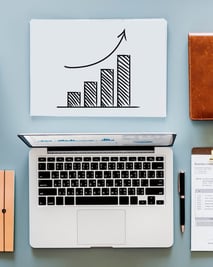Digital signage is a great way to get attention for your business. However, while the case for signage has been made by many industry surveys, how can you tell if it is right for your shop? A lack of measurable data has made it difficult for some retailers to properly analyse the impact of signage campaigns. Here we start to look at how to approach measuring the ROI of retail digital signage solutions.

The big picture: digital signage retail
Many surveys have indicated that signage - and particularly digital signage - can increase customer engagement and contribute to increased sales. In 2010, Nielsen tracked digital signage use in 120 grocery stores over time and found that four out five brands experienced increases of up to 33% in additional sales when using digital signage, compared to when using printed signage alone. 68% of customers agreed that digital signage would “influence their decision to buy the advertised product in the future.”
The wider retail industry agrees and use of digital signage has been steadily increasing. In Digital Signage Today’s Future Trends 2019 survey, 60% of retailers who didn’t yet have digital signage in their stores planned to invest in it in within the next two years.
Identifying objectives
.jpg?width=214&name=black-and-white-bull-s-eye-dartboard-70459%20(1).jpg) How do you find out if your own retail digital signage solution is measuring up to these general findings? Is it doing what you want it to? To build your own ROI measurement, you first need to be clear about your objectives for using digital signage.
How do you find out if your own retail digital signage solution is measuring up to these general findings? Is it doing what you want it to? To build your own ROI measurement, you first need to be clear about your objectives for using digital signage.
Are you trying to increase footfall into your store? Are you trying to increase sales of products in a specific section of the store? Encourage cross sales at POS (point of sale)? Or are you trying to increase awareness of a new product launch? You might be trying to do more than one of these things, but the more you can isolate your objectives, the better you can measure them.
What can be measured?
 Once you know your objective(s), what to measure should become obvious. For example, if you want a window display to encourage people to enter the store, you will want to look at the number of people in the store over a certain time period before the campaign started, compared to during the time that it was live.
Once you know your objective(s), what to measure should become obvious. For example, if you want a window display to encourage people to enter the store, you will want to look at the number of people in the store over a certain time period before the campaign started, compared to during the time that it was live.
Some examples of data that can be measured include footfall, footfall in specific areas of the store, sales register receipts, inventory tracking data and dwell time in front of a display. You are likely to have other data sources that are relevant too, depending on your campaign. For example, if you are adding a social media element, then increased social followers and use of a campaign hashtag will be part of your analysis.
Digital data sources
 If your retail digital signage solution includes IoT technology like RFID tags, beacons, proximity sensors, cameras, facial recognition, etc., you will have access to much richer data and data that’s a lot easier to gather.
If your retail digital signage solution includes IoT technology like RFID tags, beacons, proximity sensors, cameras, facial recognition, etc., you will have access to much richer data and data that’s a lot easier to gather.
For example, if you did want to measure footfall in a certain area of your store, previously, you may have had to have a salesperson (or employed a researcher) to observe and physically count the footfall, either live or via security camera footage. With proximity sensors in a display, you’re collecting this information automatically.
And with facial recognition retail signage software you can get deeper insights into your visitors and their engagement with your campaign. You will be able to see what age groups are stopping and looking at your display.
Ongoing learning process
 When you have identified objectives and data sources, you then need to plan how to collect your data and lastly how to read what the results tell you. And what they don’t.
When you have identified objectives and data sources, you then need to plan how to collect your data and lastly how to read what the results tell you. And what they don’t.
Sometimes it’s not possible to directly link signage to sales. You may have a very engaging campaign, but people don’t act on it immediately, or, you see increased sales, but it’s difficult to isolate other factors that were acting in combination, like your other marketing or discounting. You may need to experiment with your measurement plan and measure over a longer time period than originally planned to identify trends.
 For advice about retail signage software and how to make sure your signage is working as hard as possible for you, contact our experts. Cenareo retail signage solutions provide the easiest way to fuse digital and physical shopping to create an amazing, yet cohesive multi-channel experience.
For advice about retail signage software and how to make sure your signage is working as hard as possible for you, contact our experts. Cenareo retail signage solutions provide the easiest way to fuse digital and physical shopping to create an amazing, yet cohesive multi-channel experience.
